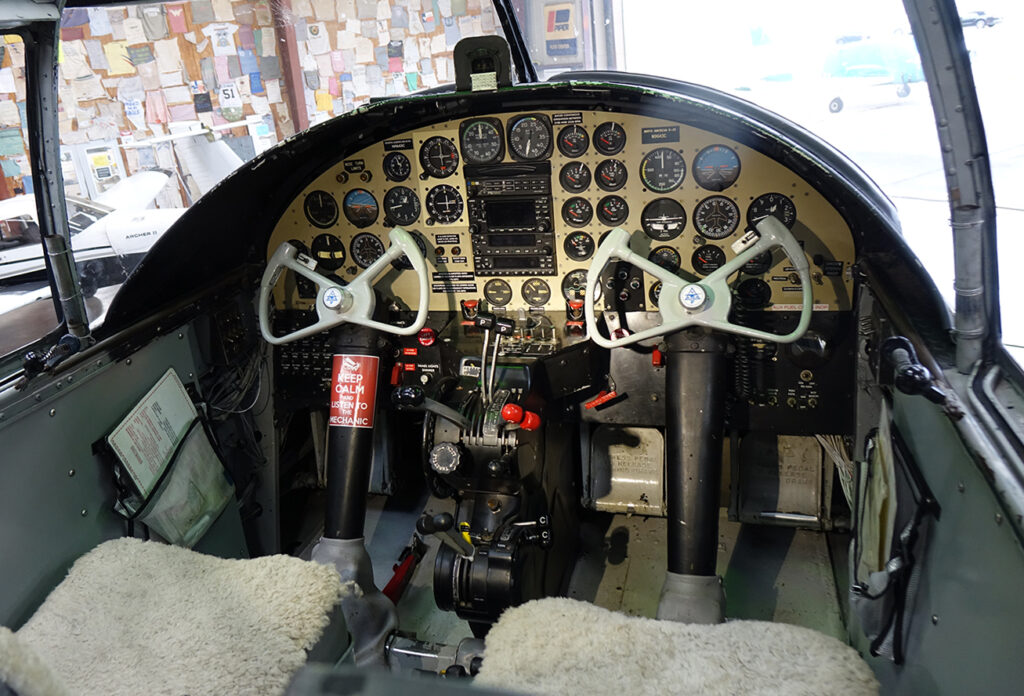cover photo by Ashley Shelton, courtesy of Beth Jenkins
Nobly hangared at Pilot’s Choice Aviation at the Georgetown Municipal Airport is a piece of history just waiting to tell you a story of the men and machines that defeated Nazi Germany, Imperial Japan, and Fascist Italy.
The B-25 “Devil Dog” medium range bomber is part of the nation’s Commemorative Air Force (CAF), which includes 88 units and 155 other planes and, combined, is the largest flying museum in the United States. The Devil Dog Squadron is supported entirely by volunteers who give of their time and resources every day. They also spend many weekends away from home to keep history alive, educate and inspire younger generations, and honor the Airmen and Marines who flew B-25s over every combat theater in the world from 1941 through the end of World War II.
VMB 612
The Devil Dog is painted to memorialize ship number three of the Marine Bombing Squadron VMB-612. The original aircraft were the first group outfitted with radar, enabling them to locate and attack targets at night. The restored #3 plane is adorned with artwork representing 22 missions, during which the crew downed three merchant ships and one Imperial ship. Pilots were known to “skip-bomb”—approach a ship at low altitude, only 20 feet above the decks, drop their payload, and pull up quickly while being fired upon.
The Devil Dog is a Marine version purchased in 1978 by the CAF. They sold it in 1980 and it was donated back to them in 1982, after which it was restored by Ozzie Parrish, a member of VMB-612 who wanted to honor his friends. Georgetown volunteers have continued to maintain the appearance and airworthiness of the aircraft for air shows, static displays, field trips, and visits from anyone with an interest.
KEEP HISTORY ALIVE
The Devil Dog Squadron is booked nearly every weekend at air shows and flyovers, and logged many hours in 2020 appearing over parades, hospitals, and veteran events. They are always eager to encourage and entertain, including an Easter egg drop for Georgetown families.

Scott Maul, Development Officer for the Squadron, says, “The direct and indirect costs of the plane are about $2,000 per hour of flight time. But we like to say the plane actually runs on cotton. We have a wonderful selection of t-shirts, caps, challenge coins, and other branded items that help us keep up with operating costs. When folks bring their family to the hanger to see the plane, the visit and the tour are free, but we invite everyone to make a purchase or a donation to help us continue our work around Texas and the nation.”
The volunteers and crew enjoy touring the country and are especially delighted when they meet individuals who flew, maintained, or helped build the planes, many of whom have left their signature inside the fuselage. The crew also enjoy providing creative experiences, including guest flights, scattering ashes, and even a wedding.
Flight enthusiasts can reserve a Living History Flight Experience online or in person at air shows. Strap in, put on a headset—and enjoy the sensory experience that, decades ago, had the same sounds and smells. Looking around the interior, you can almost see anxious young Marines in oxygen masks, poised at their guns and radios, focused on task for eight hours at a time, en route to 30 minutes of feverish combat. Devil Dog Rob Chalmers says, “It’s amazing what the tour does for Veterans. There is something about being in the airplane takes them back to an earlier time and their recollection is very clear.”
BE A PART OF IT
Beth Jenkins, owner of Pilot’s Choice, says visitors are welcome to check in at Pilot’s Choice to see the plane. “Monday through Thursday, someone is here to act as docent and share the history of these great planes and crews. We encourage people to come and visit with their families to be reminded of this important history; a history that will repeat itself if we don’t keep it alive.”
Their monthly membership meetings are also open to the public; offering a great opportunity to meet members and learn more about the group. Meetings are usually followed by work on the aircraft or preparation for the next airshow, allowing you to get up close and personal without the usual crowds that surround the Dog at airshows. Click to donate or get updates on appearances and events.
